1lumen selects and reviews products personally. We may earn affiliate commissions through our links, which help support our testing.
Nitecore TM12K review
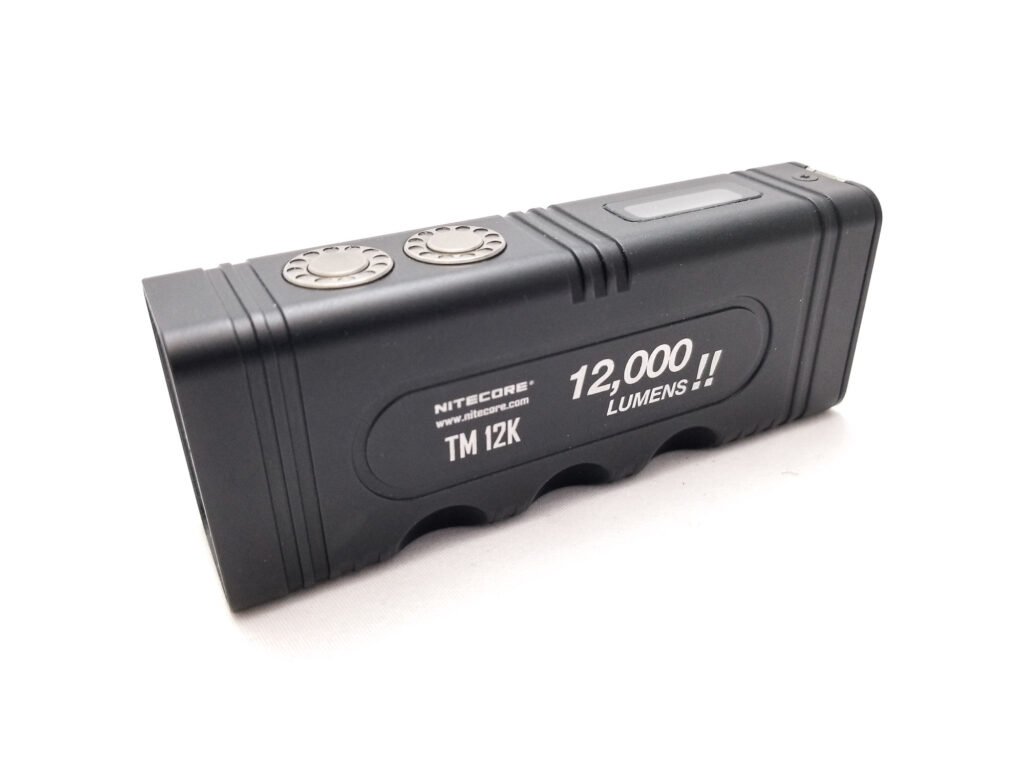
Nitecore TM12K specifications
| Brand & Model | Nitecore TM12K |
|---|---|
| Flashlight category | High Output General Purpose |
| LED | 6*Cree XHP50.2 |
| Max. output | 12,000 lumens |
| Max. beam distance | 250 meters |
| Max. beam intensity | 15,600 cd |
| Battery config. | Built-in 4800 mAh 21700 |
| Onboard charging | USB-C port |
| Modes | 5 |
| Blinkies | None |
| Waterproof | IP68 |
| Review publication date | December 2022 |
Introduction:
Anyone who knows anything about flashlights knows Nitecore as a purveyor of practical, high-performance, good-quality flashlights with quirky features. Quirks aside, their product line is expansive: From small AA/AAA lights to crazy high output multi-LED lights. Moreover, these lights appeal to professional users as well, and their tactical and duty lights hang on the utility belts of law enforcement, security, and service techs all over the place. Unlike other Chinese flashlight companies, Nitecore shores up their products through a network of brick and mortar retailers and wholesalers as well. I’ve reviewed the Nitecore MH40S and despite the way-too-green LED, I really liked it.
That light was a tactical-style thrower, but now Nitecore sent me a new light to test on, the Nitecore TM12K. Yep, as the TM designation implies, this is part of their Tiny Monster series high output lights and an upgraded version of the 10,000 Lumen TM10K. Although it’s more of a general purpose light, Nitecore goes so far to market this as a tactical light. Hmmmm. I doubt it, but spec-wise it’s definitely got some spunk. Specs say 12,000 Lumens, 6 Cree XHP50.2 LEDs, a unique rectangular form factor, simple triple switches, and a simple UI with some bonus features. It’s also sporting a cool OLED display all packed in a way-too-small-for-12,000 Lumens form factor. Is it tiny? Yep. Is it a monster? Maybe. How about tactical? I’m skeptical, but I don’t mind surprises.
Package quality.
The TM12K came in a pretty premium-looking lift-off lid box with a blacked-out theme with some specs on it. Overall, I really liked this packaging and it nicely represents the premium price tag. Inside the TM12K was sitting in a cutout with a box of accessories to the side similar to Olight’s packaging. Here’s what you get:
- TM12K flashlight
- Lanyard
- USB A to C charging cable
- User manual
- Holster
This is a proper assortment of accessories, including everything needed to get going with no extra purchases needed, which is what I expect from Nitecore. I thought the lanyard was broken, but apparently, it’s supposed to be that way and meant to help thread the lanyard through the hole.

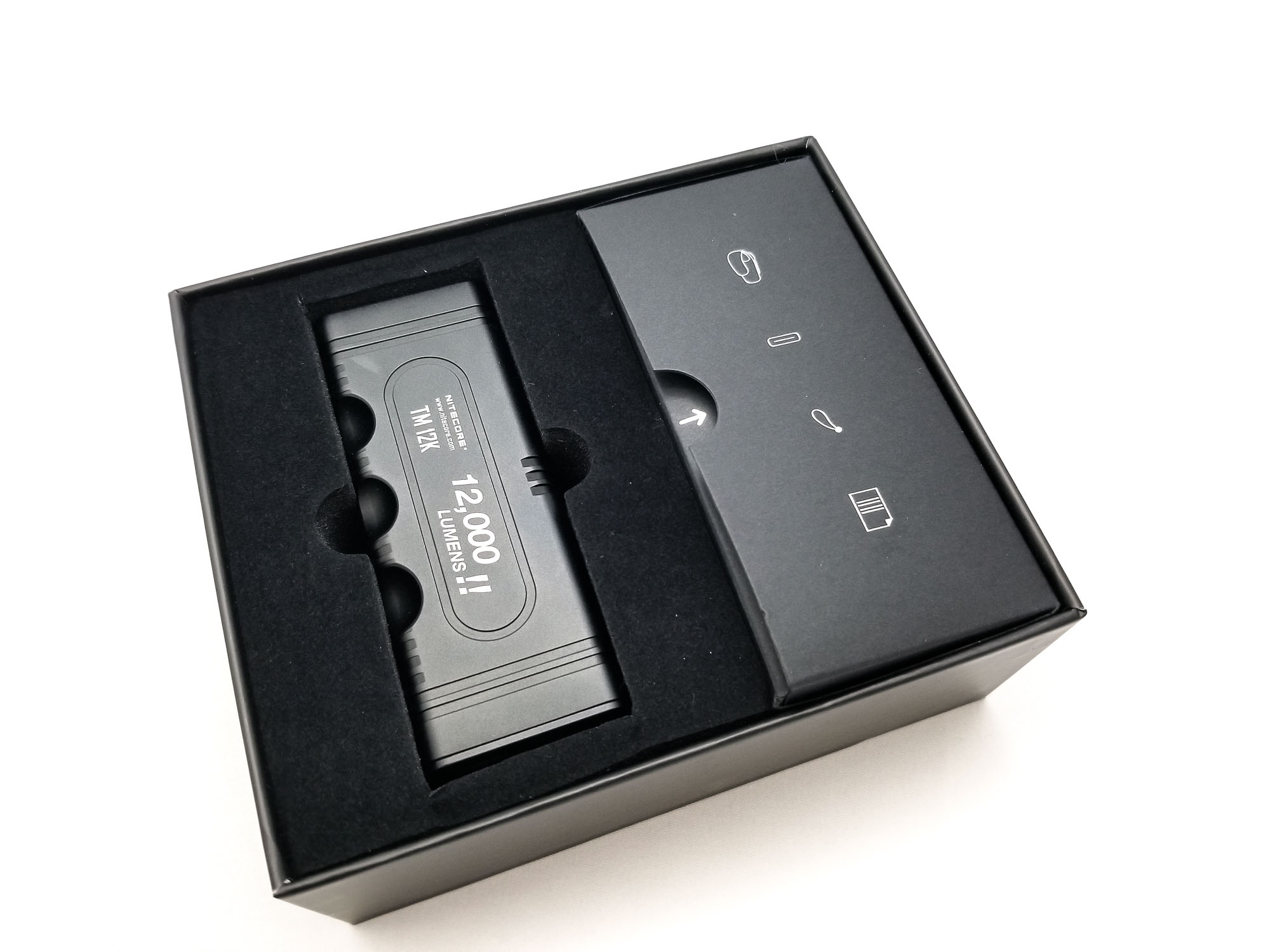
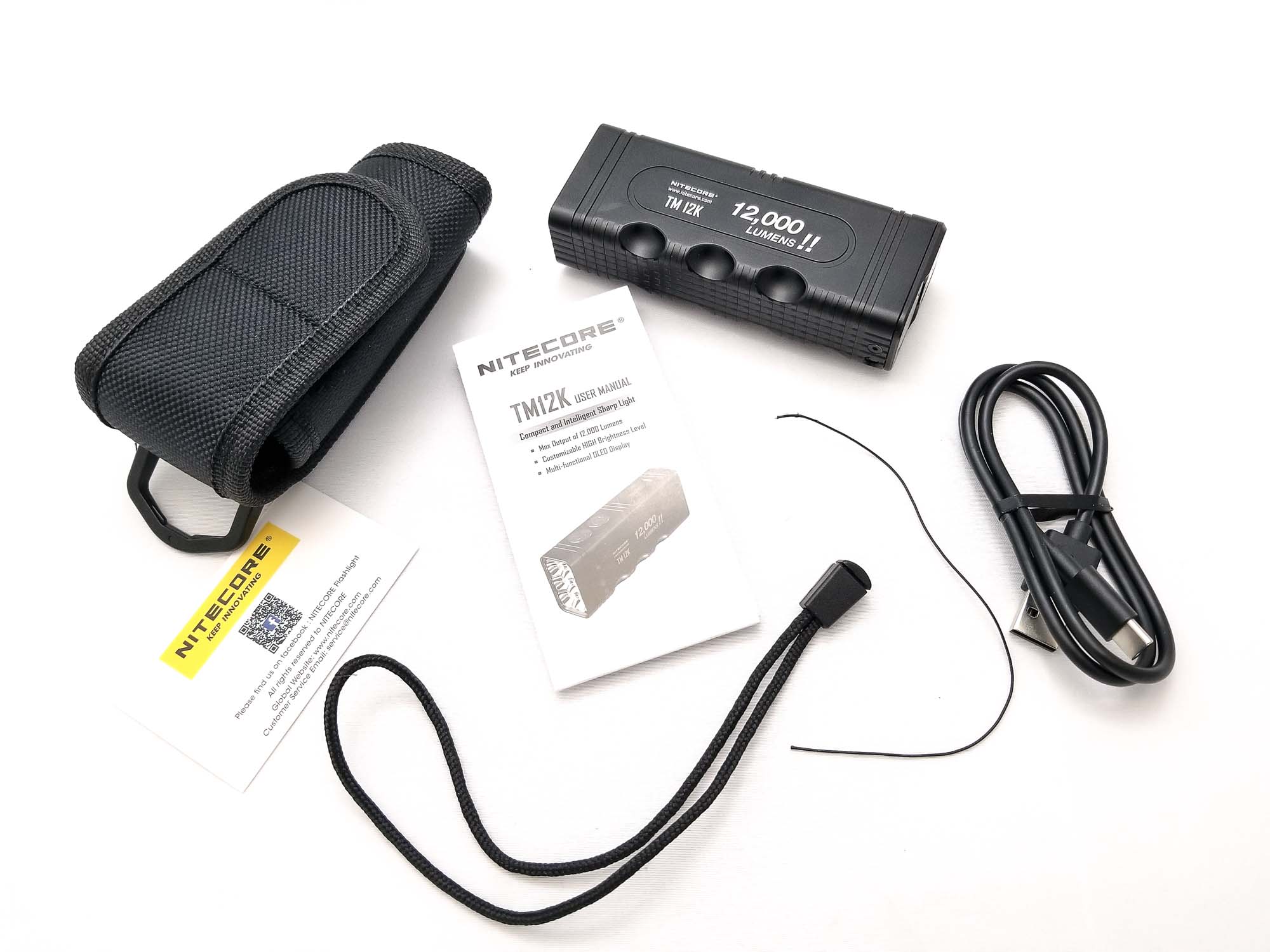
Flashlight in use
Here’s where the quirky and unique nature of the Tiny Monster series comes into play. The TM12K is a high output flood machine, casting a lot of light over a large area. It’s not much of a distance light, realistically good for 200 meters, but for up-close it’s perfect. Thanks to the mode ranges, it makes a great general-purpose light as well. Could you carry it in a duty or tactical use capacity? The side opposite the pocket clip pretty much sums the TM12K up in a nutshell with “12,000 Lumens!!”
The TM12K features a rectangular form factor, about the same size as an ice cream sandwich. It is similar to the Fenix LR35R, LR40R, and Streamlight Stinger 2020 which have square bodies with round heads. The body is small enough to get a good purchase, and after handling this light, I think this would fit smaller hands better than larger ones. There’s some texturing on what should be the bottom (opposite the switches), and some grooves cut into the topside to the rear of the switches for grip. I found it particularly good in the overhand (ice pick) grip. There’s finger grooves on one side of the body to aid in gripping, and I think they work. The switchgear consists of three e-switches: Two on the slim side up top, and a wide, flat one at the rear. These have metal covers, and the two up top are for on-off and mode switching, special functions, and lockout. The rear is for momentary Turbo use only. The top switches are plain, but the rear has a single blue indicator LED in the middle for on state. I am not a huge fan of these switches. The rear switch sits flush with the rear of the body, and it feels a bit like the charge port cover, so it sort of blends in when feeling for it in the dark.
The rear switch travel is almost non-existent, and it takes a bit of effort to activate, which while good for mitigating accidental activation, isn’t so good due to the fact it’s hard to get a solid grip (at least for my big hands) on the light to easily actuate it. The front switches also have very short travel, and with the ultra-flat buttons, almost got lost in the dark, only aided by textured bezels. I suspect gloved hands would make it worse. I didn’t care for the rear switch placement either. The square, short body required some careful maneuvering to get my big hands in a position to actuate the rear switch like a thumbless monkey playing with a football, and the best/easiest way was to grip it from the wider side, lying flat in my hand. I think in a stressful situation, that might be an issue and this almost eliminates any ‘tactical’ use cases right off the bat.
There’s a pocket clip on one side of the body secured with three T6 Torx fasteners, so I did what any curious person who owns a set of small Torx bits would do and removed said fasteners. Voila! Instant clip delete! It’s a good clip with a wide contact area, and orients the light for bezel down carry with good tension for a secure hold. I pocket carried this light like an EDC for a few days, and it actually wasn’t bad. The flat sides and thin profile made it less obtrusive than a 21700 size round flashlight. The included holster seems sturdy and has a plastic D-ring for clipping to battle rattle, turnout, MOLLE gear, or a duty belt. The light fits very securely in the holster, and with the clip affixed, it’s only good for bezel-up carry, but with the clip gone, you can holster it in either orientation. The holster bottom is open so the rear of the light is unprotected (along with the rear switch), so yep, accidental activation may be an issue. Out back, there’s a lanyard hole that’s generously-sized (if your lanyard doesn’t come in two pieces), and it looks like ⅛” paracord would fit just fine.
There aren’t many flashlight manufacturers fielding lights with external displays (Imalent does). Like other Nitecore TM lights, the TM12K features a small monochrome OLED display. When you press either of the two top buttons, it will show battery voltage and a ‘standby’ message for about 10 seconds. A short press on the mode button will activate the screen. When the light is clicked on, the display will cycle and show (in order) the mode selection and output, battery voltage, a battery state graphic, estimated runtime, and the flashlight temperature. When Turbo is activated, it displays a progress bar that fills in to show the Turbo timer limit. It also shows when the Turbo limit has been reached and a filled-in bar that slowly recedes as the light cools off. Cool.
When charging, it also shows whether the light is being quick charged (or not), and shows the battery voltage. I don’t see this isn’t gimmicky at all and I really liked this feature since it’s a nice departure from the boring LED indicators on virtually every flashlight. The temperature reading was a bit off, but pretty close, and the voltage readout showed real-time battery voltage. Under load, the voltage changed as the battery sagged. Nice!
Tail standing is fine and stable, which is very important for a light like this for area lighting during blackouts.
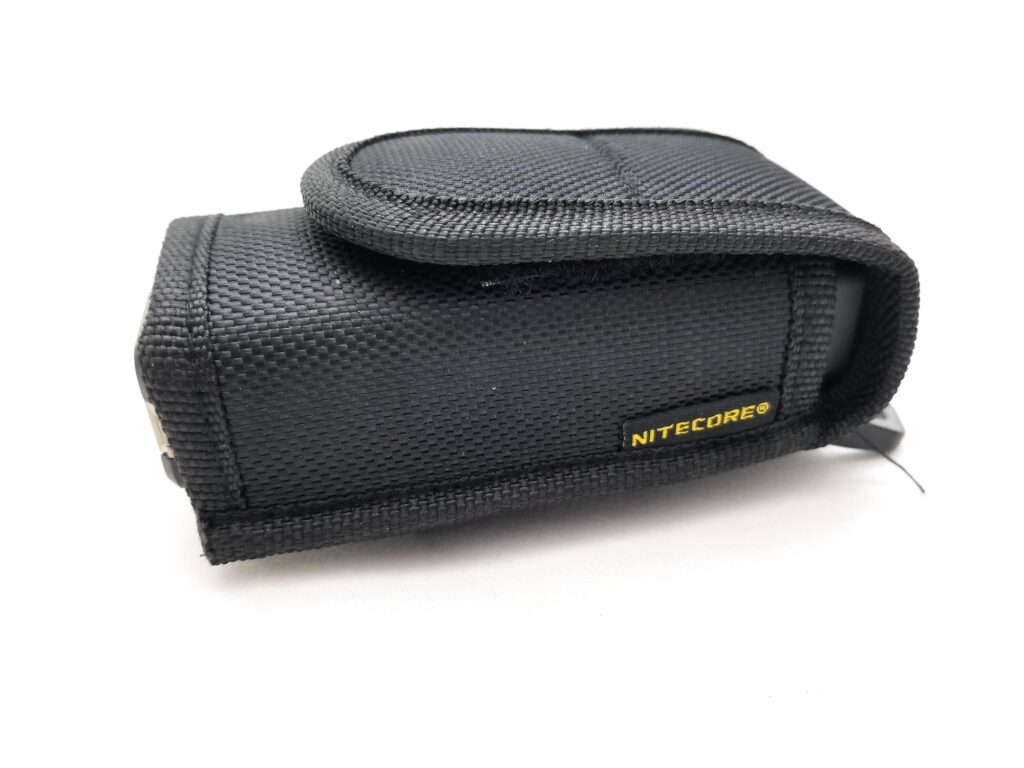
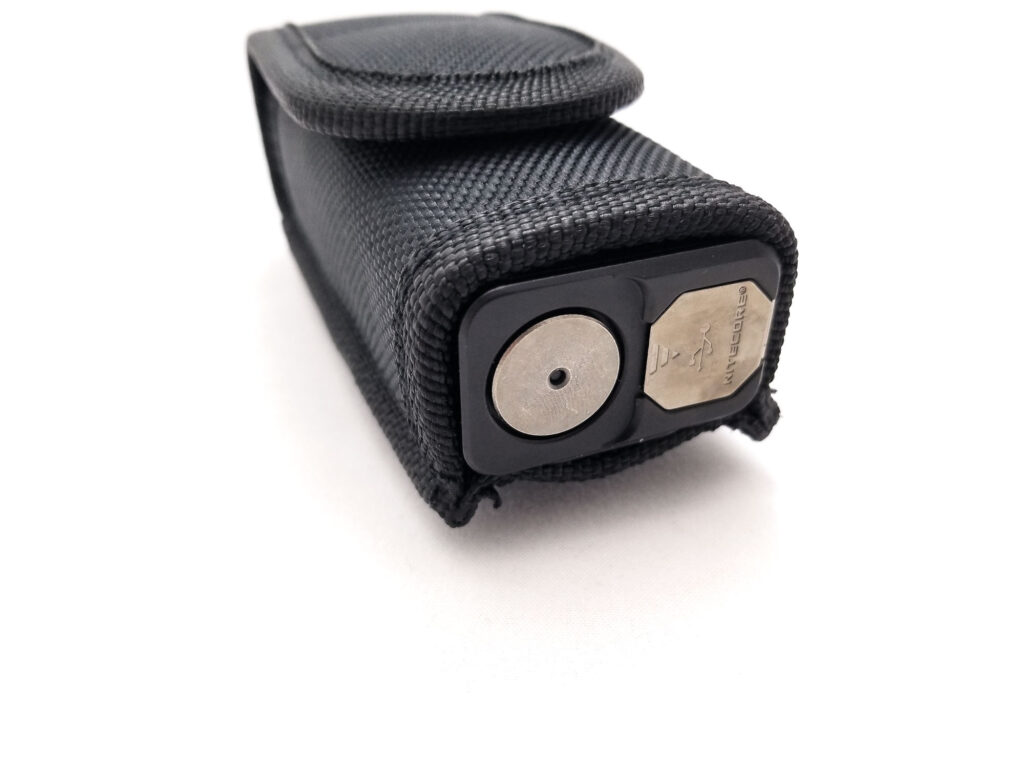
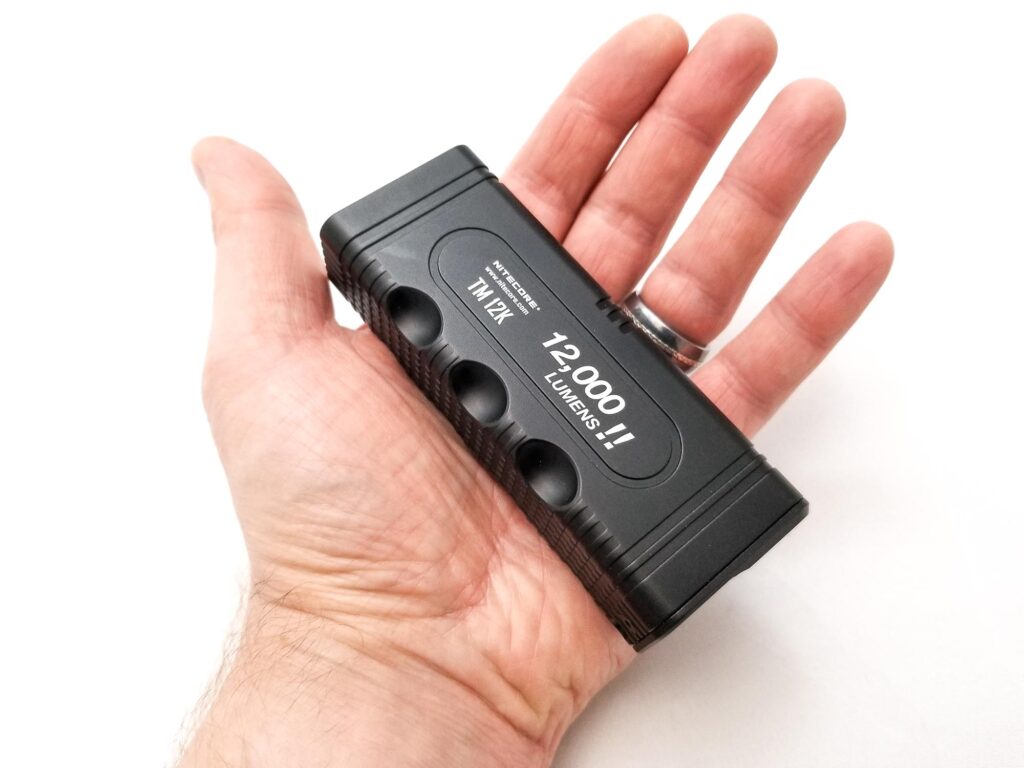
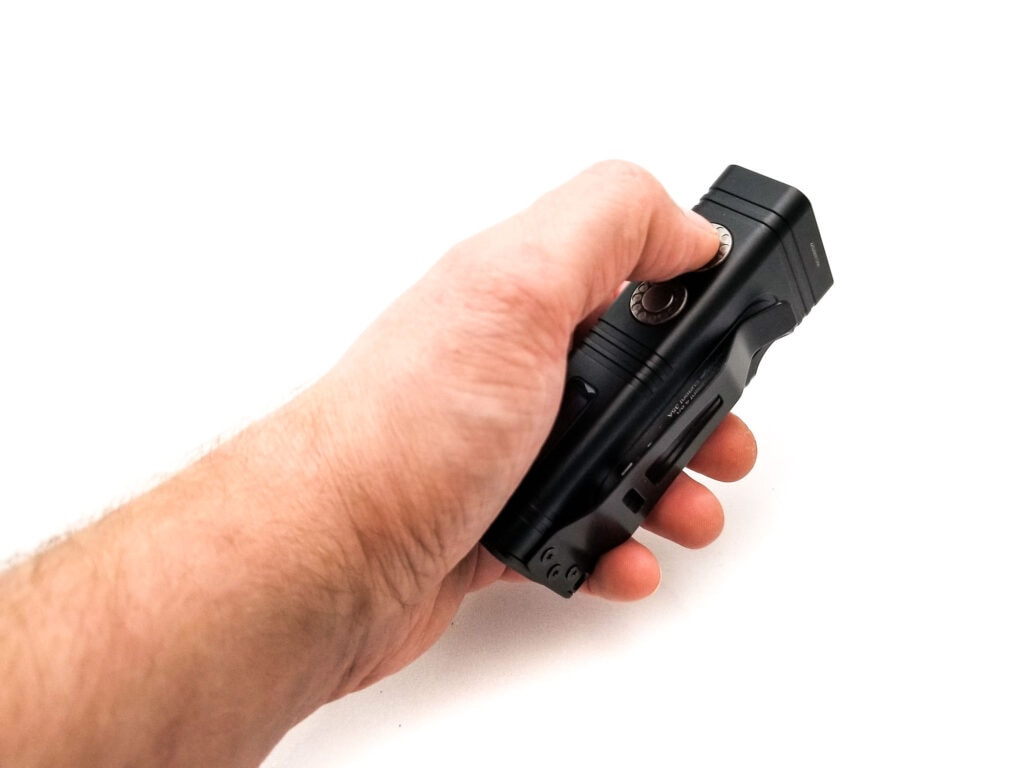
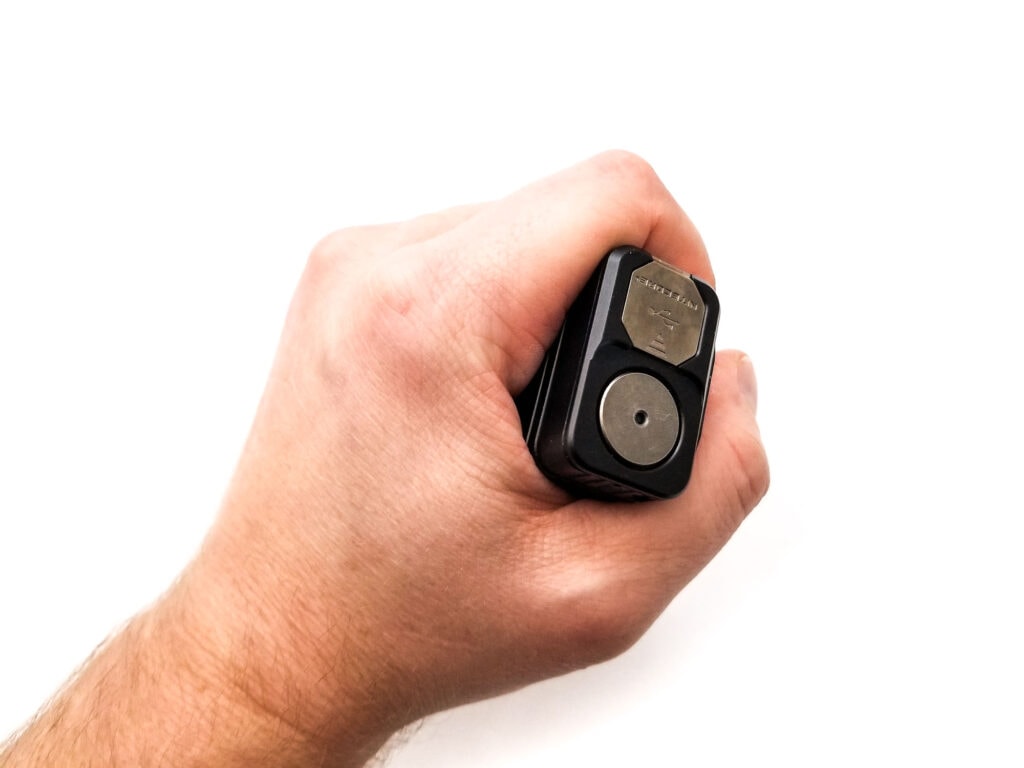
Build Quality, and Warranty
The MH40S I tested was very well-made and high quality, and this TM12K is more of the same, with nice build quality, nice attention to detail with fit and finish, and good quality control. It had better be because Nitecore wants around $260 US for it. That’s a lot of cabbage for a small flashlight.
The light is a unibody design, with a solid chassis featuring an integrated LED shelf and a 4 mm thick copper MCPCB. The light is milled from A6061-T6 aluminum alloy, and the machining is exquisite with no defects, chips, burrs, or tooling marks. There’s no sharp or abrupt edges anywhere, and the black type III HA anodizing is very well done. I didn’t see any blemishes, thin spots, or issues with the anodizing, and after some rough pocket-carrying, it’s held up great.
The silkscreen text is sharp and has good contrast as well. The charge port cover is loose and floppy, and doesn’t have any o-rings or rubber gasket sealing it. It’s just a metal door held in place with a couple of tiny magnets embedded in the unibody. The cover fits flush with the body, and wasn’t easy to open by accident. The light is completely sealed with no user-serviceable parts, so naturally, ingress protection should be good, and Nitecore concurs with an IP68 rating. The TM12K won’t roll away if left on an inclined surface since it’s, well, flat. Who knew…rectangles don’t roll away.
Nitecore warranty is up there with the best of the best. For lights with removable batteries, it’s 5 years (60 months) for factory defects or workmanship defects not resulting from abuse or misuse. For lights with integrated batteries (like this TM12K), the warranty period is 2 years (24 months). All lights receive product support after the warranty period expires through Nitecore’s limited lifetime warranty coverage for labor costs and maintenance, but no coverage for replacement parts. The catch here is the full warranty coverage with RMA support applies if purchased directly from Nitecore or a Nitecore authorized reseller. Third party warranty coverage is trickier and in lieu of an RMA, there’s a surcharge totaling 3% of the purchase price to cover shipping and maintenance costs. Bottom line: Buy from Nitecore or an authorized reseller to get the most out of the warranty (oh, and don’t crack open your Nitecore to swap out that 6500K XP-L2 either).
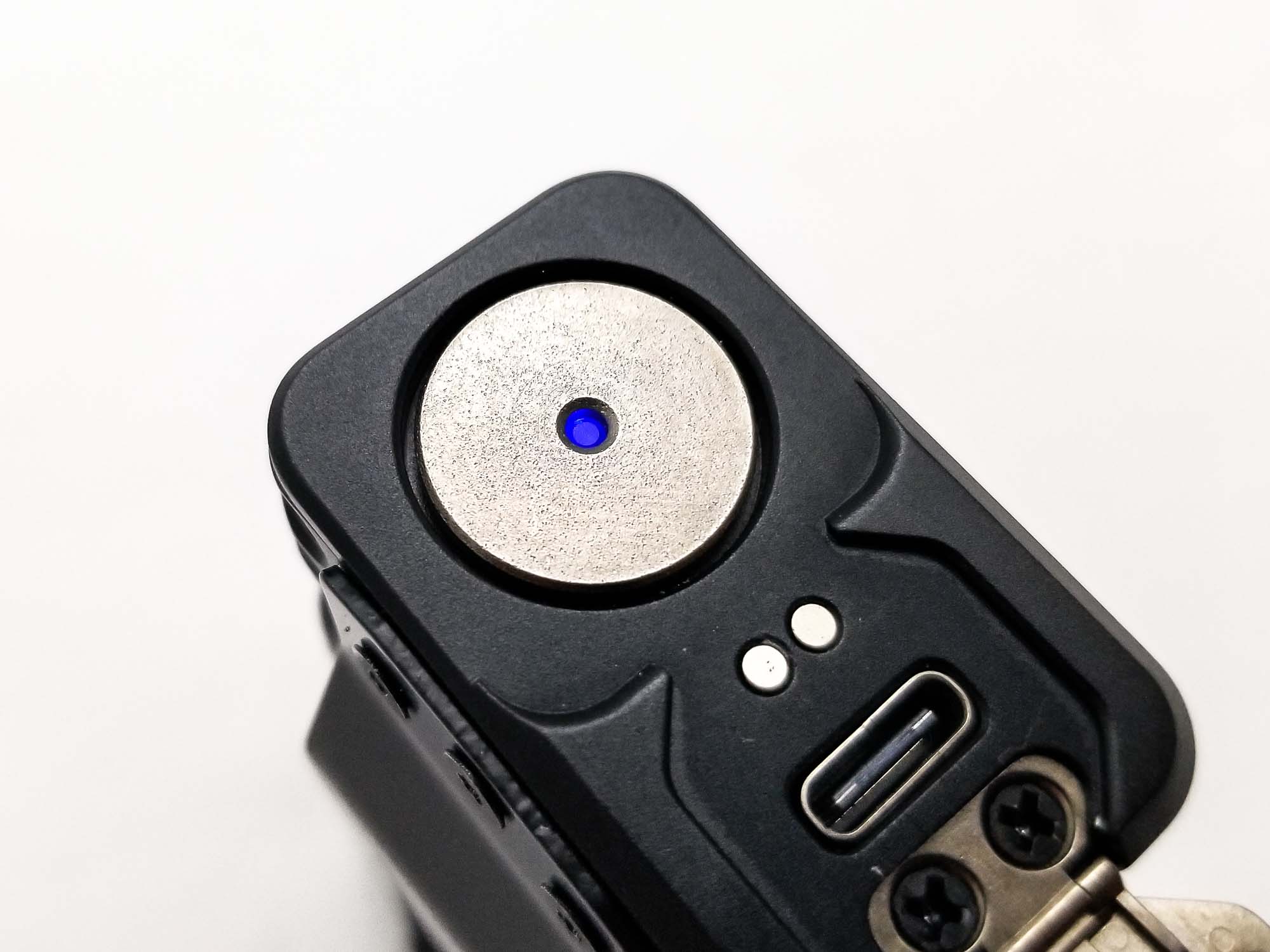
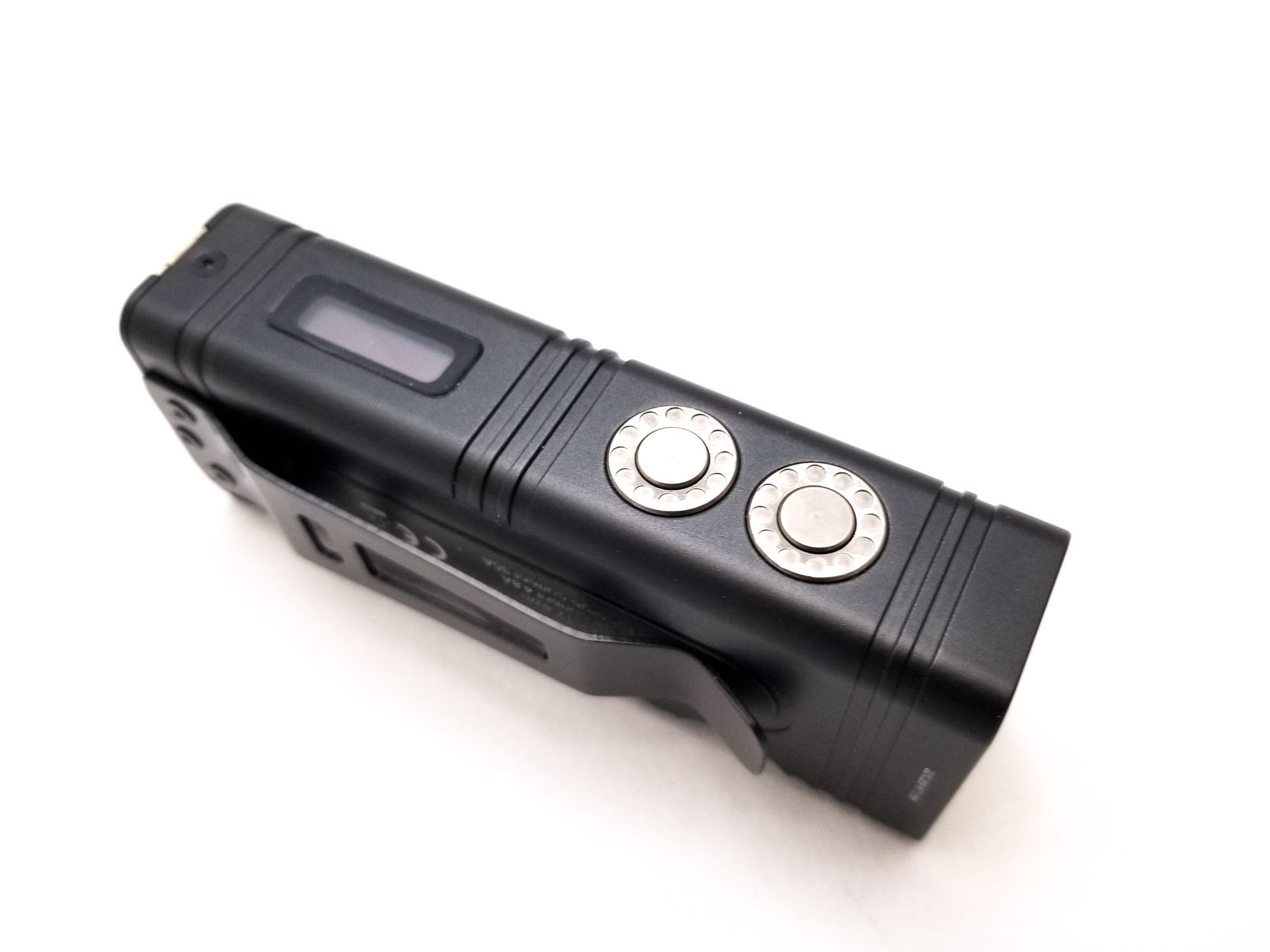

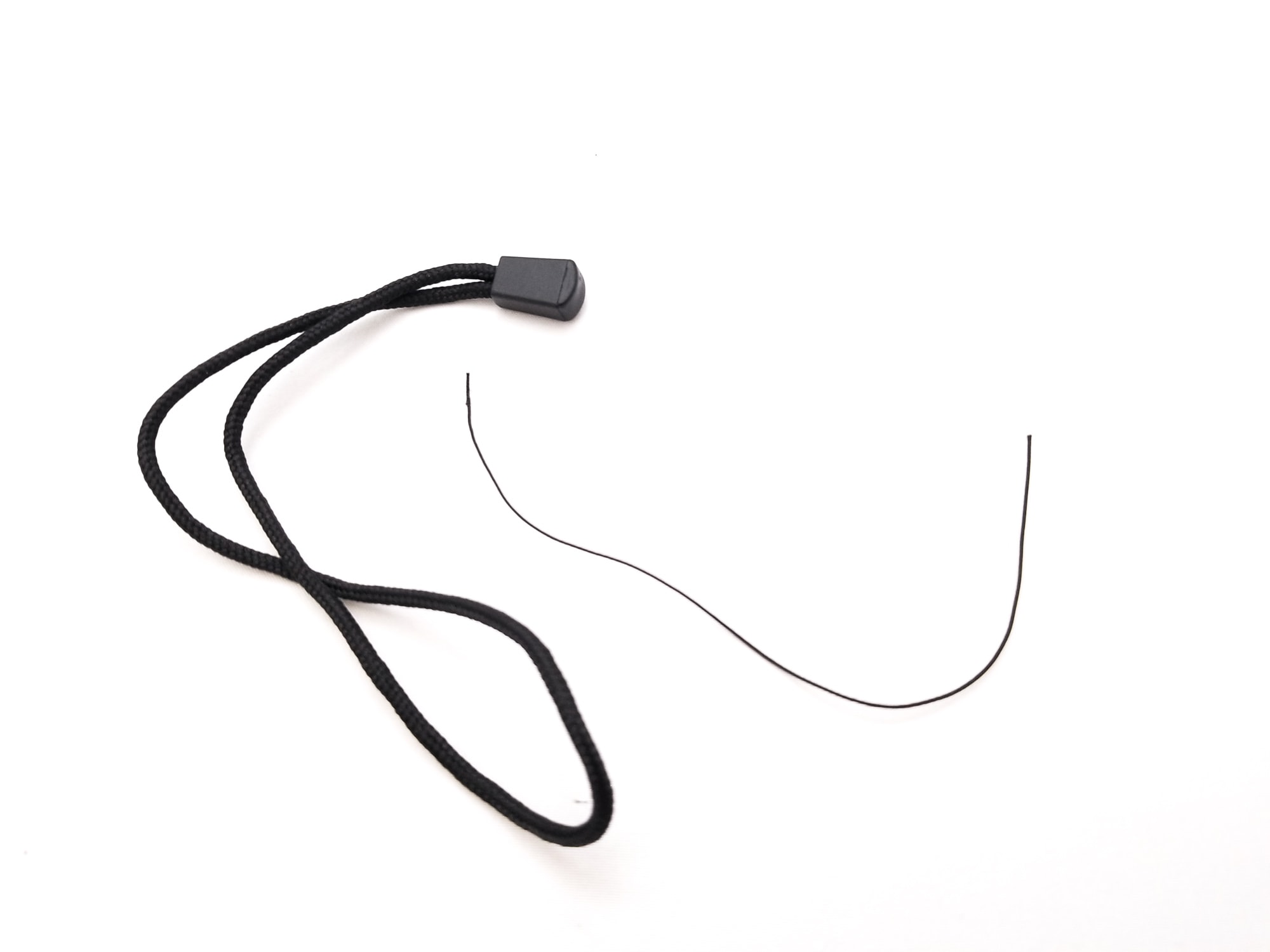
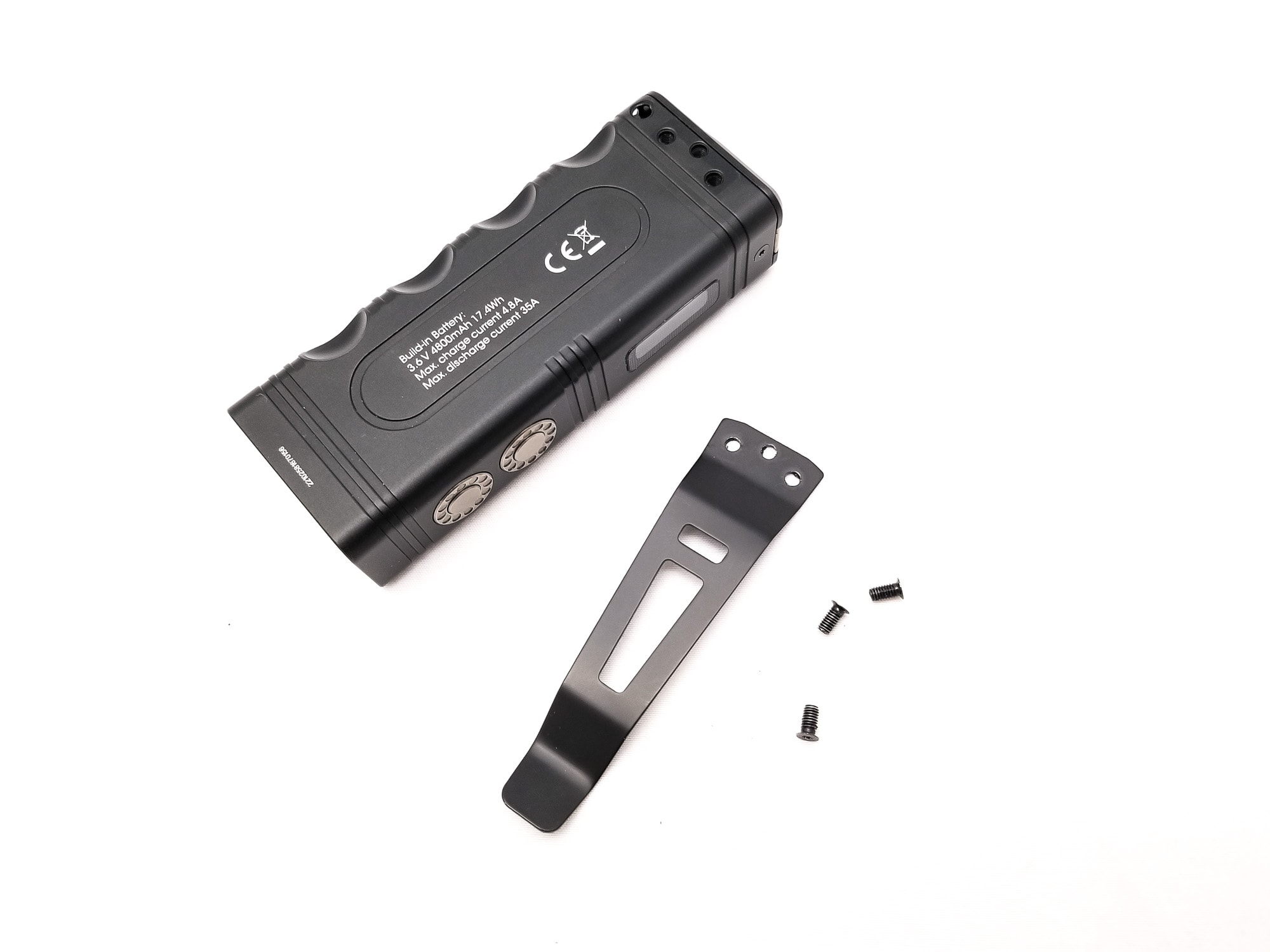
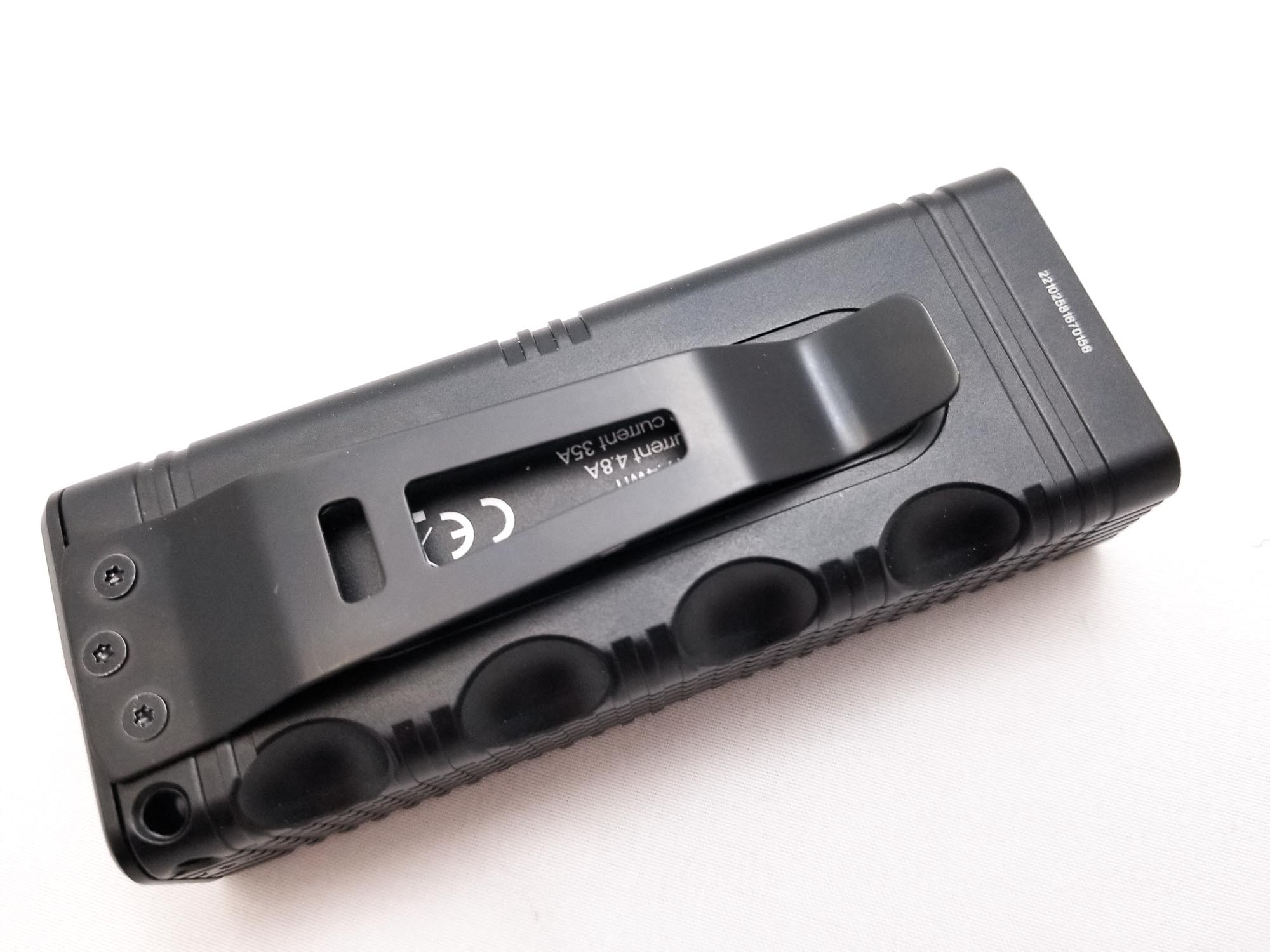

LED, Lens, Bezel, Beam, and Reflector
Like the TM10K, the TM12K features 6 LEDs. The former had 6 Cree XHP35 HD (domed) LEDs, which are 12-volt LEDs running on a boost driver. For the TM12K, the XHP35s have been ousted in favor of the CREE XHP50.2. These LEDs have proven themselves in a ton of flashlights as high output, high efficiency emitters. Built on the 5 mm by 5 mm footprint (same as the SST40 and SFT-40-W) with a CSP quad-die LES. In 3 volt configuration, these are capable of huge output if direct driven. I don’t know if Nitecore is using 3 volt or 6 volt XHP50.2s, but I’m leaning towards 3 volts. The great thing about Nitecore is they make choosing LED tints really easy…any tint you want as long as it’s cool white, and these XHP50.2s are indeed cool white. On Turbo at 2 meters from the sensor, the Opple Lightmaster Pro has them at 5937K with CRI Ra 66.5 with the duv coming in at 0.0057.
The reflector is a 2×3 arrangement, with a bank of 3 LEDs on each side. Each LED sits in its own very shallow smooth reflector. The whole array is topped with a piece of AR coated mineral glass lens. There’s no bezel, but the edge of the housing extends maybe 1 mm above the lens to afford it some protection from drops, but it’s otherwise unprotected. Okay, we all know that domed XHP+smooth reflectors=ugly beams, angular tint shift and chromatic aberrations, and no surprise, that’s what you get with the TM12K. There’s a lot of blue-white side illumination in a wide pattern, interrupted by a pee yellow central hot spot on any mode except Turbo. On Turbo, it morphs into a less-than-pee-yellow hotspot surrounded by very bright white spill. I think the XHP50.3 domeless LEDs would have been a much better choice for this light (hint, hint Nitecore).

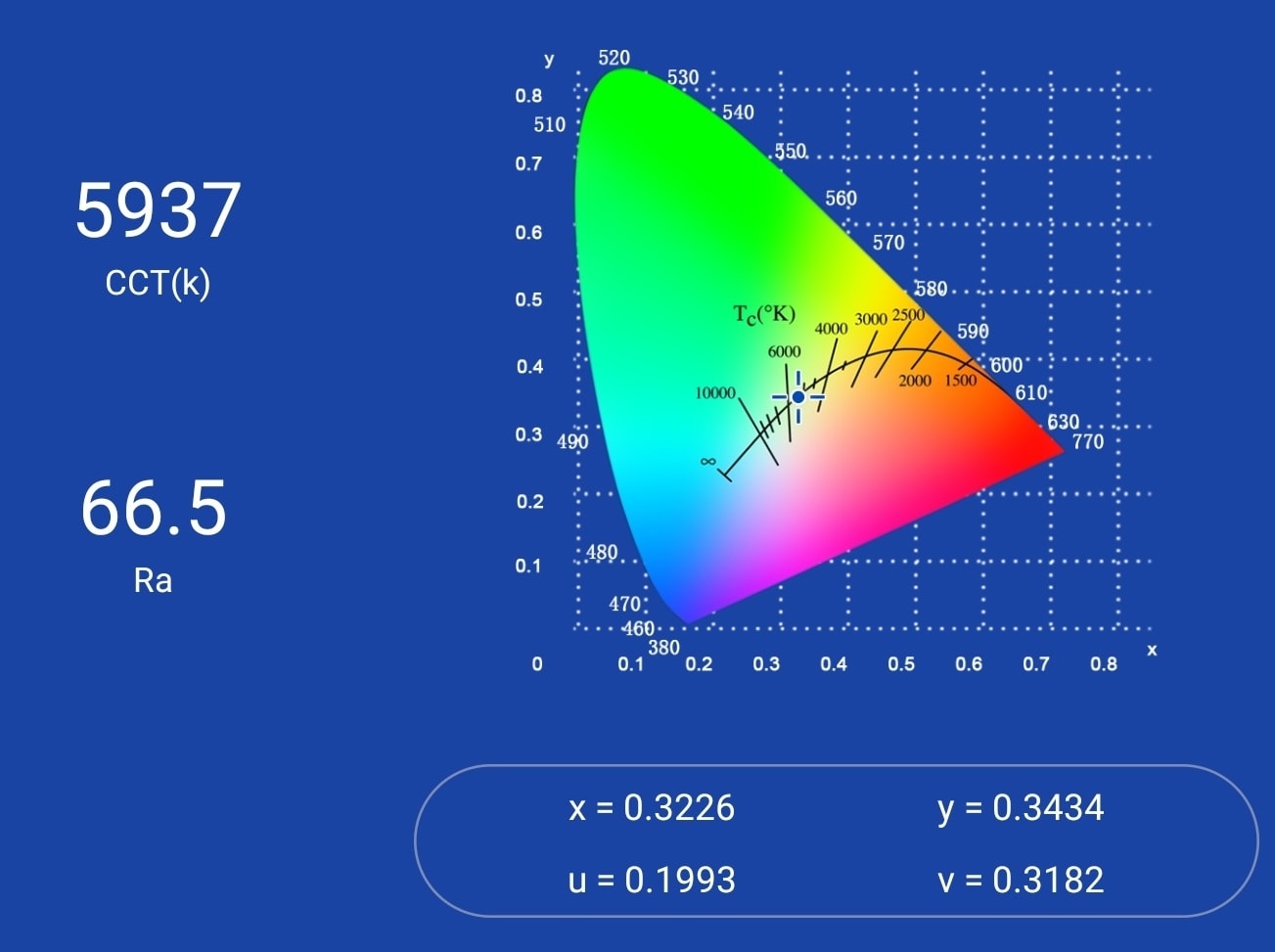
Dimensions and size comparison
Dimensions:
| Dimension | Millimeters | Inches |
|---|---|---|
| Length | 108 mm | 4.2 in |
| Head diameter | 31 mm | 1.2 in |
| Body diameter | 41 mm | 1.6 in |
Dimensions are rounded to the nearest millimeter, and to the nearest tenth of an Inch.
Weight:
| Weight | Grams | Oz. |
|---|---|---|
| With battery | 237 g | 8.5 |
Weight is rounded to the nearest gram, and to the nearest tenth of an Oz.
Flashlight size comparison with its competition
I compared the TM12K with some true, duty and tactical-use flashlights for the first group, and more conventional, high output flashlights for the others.
Group 1 left to right: Klarus XT11GT Pro V2, Fenix PD36 Tac, Nitecore TM12K, Fenix TK20R V2, Fenix TK16 V2
Group 2: Imalent R30C, WildTrail WT3M, Nitecore TM12K, Sorifn SP36 Pro, Astrolux EC03
Reflector shot: Imalent R30C, WildTrail WT3M, Nitecore TM12K, Sofirn SP36 Pro, Astrolux EC03
Group 3I also compared it to the semi-rectangular Streamlight Stinger 2020, which has a rectangular body and round head.
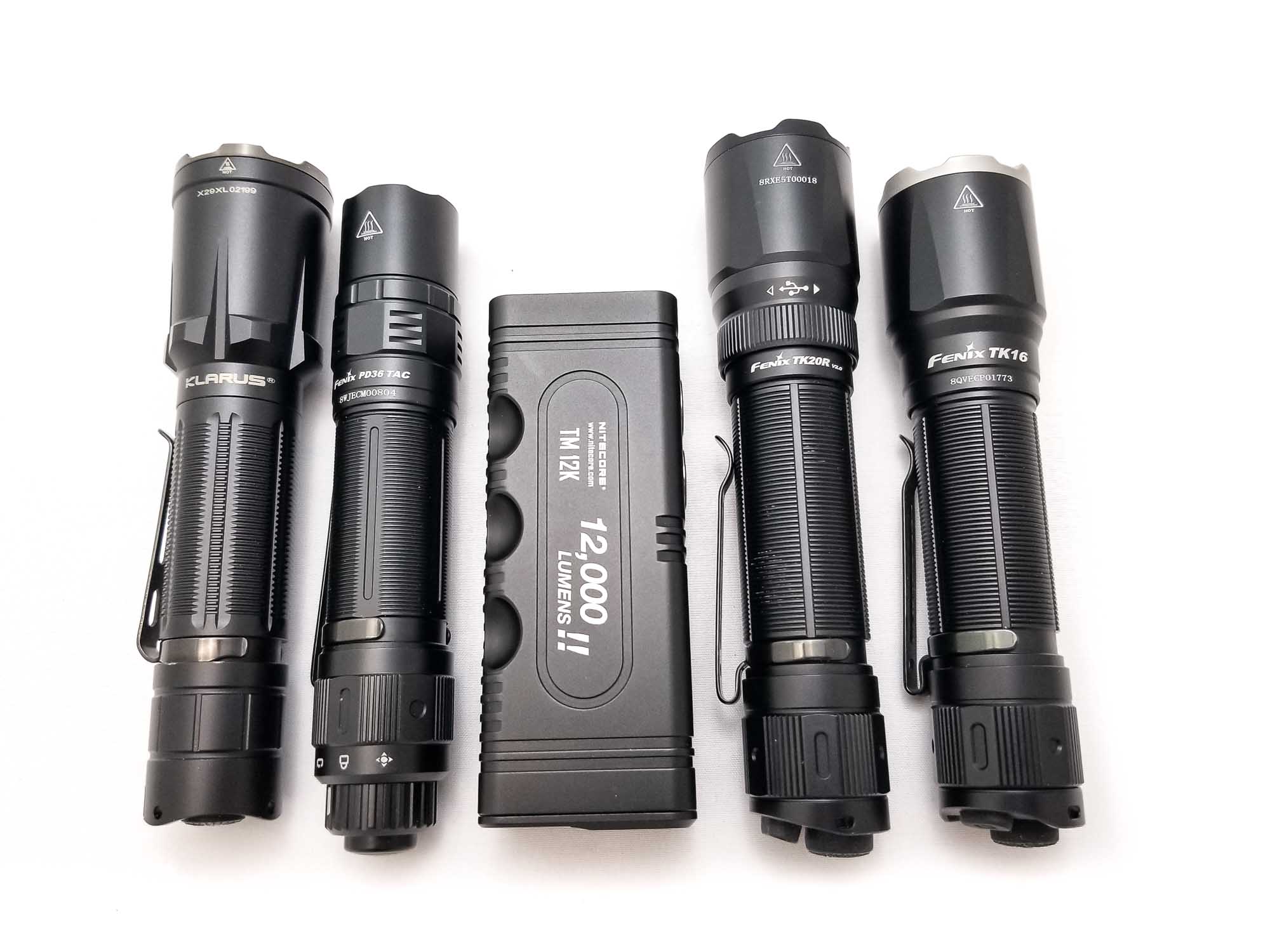

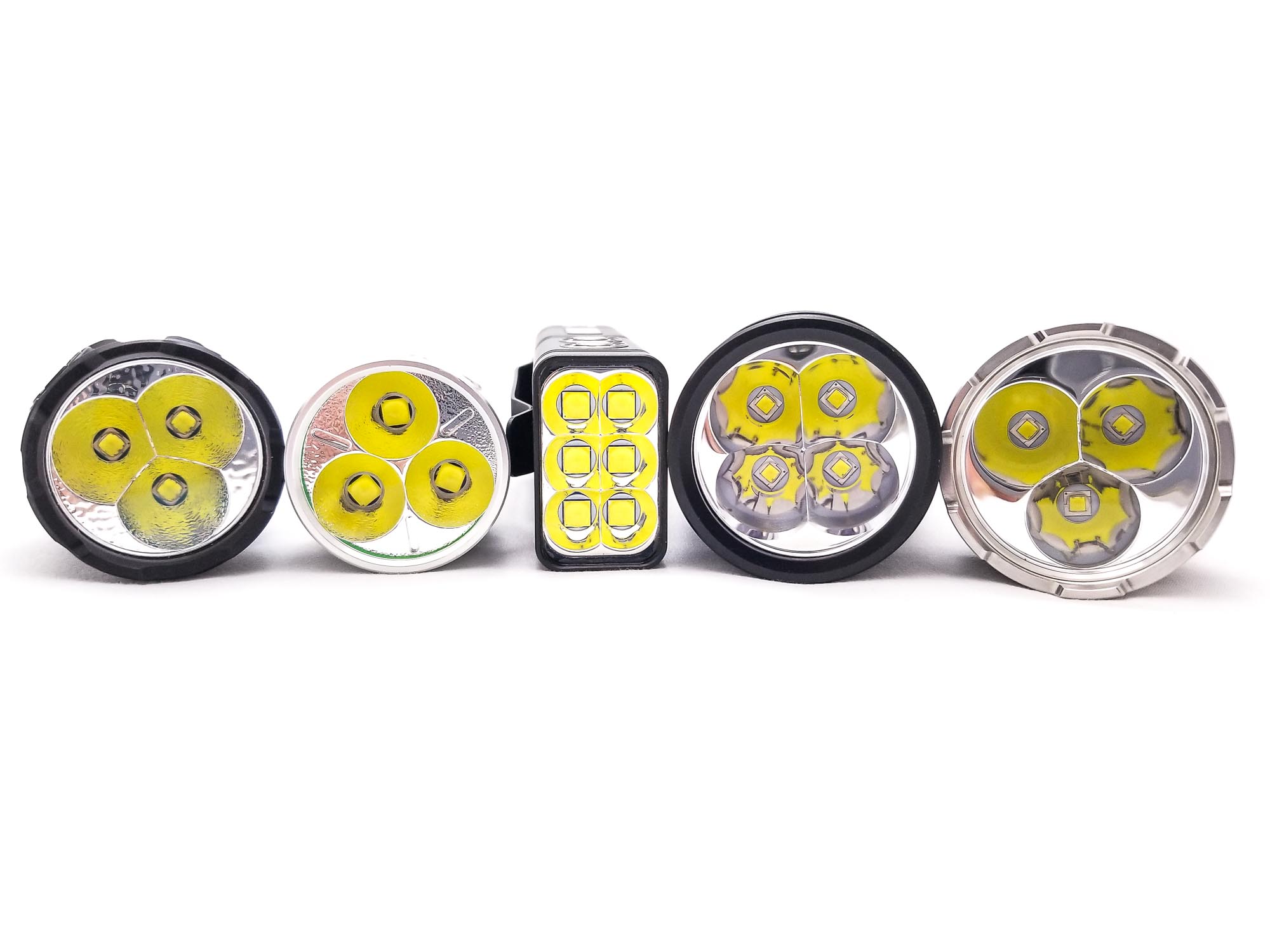


Driver & User Interface:
The driver is anyone’s guess here, but it’s probably a hybrid buck driver with a FET direct drive channel since Turbo draws quite a bit more current than most buck regulators can provide.
The UI is interesting but pretty conventional with 5 standard modes (including Turbo) and no blinkies. This UI has some tricks up its sleeve though with user-adjustable brightness for the High mode. It’s designed around the two top switches and the rear switch. The two top switches control on/off (the rearmost “power button”) and mode switching (the forward switch “mode button”). The rear switch is for momentary Turbo only.
Modes: Ultra Low, Low, Medium, High, and Turbo
From OFF:
- Single click power button: Turns on in last mode
- Press rear switch: Instant Turbo
- Long press power button: Ultra Low
- Long press mode button: High mode
- Click mode button: Activates multifunction OLED display
From ON:
- Single click power button: Turns off
- Single click mode button: Switches modes
- Press and hold the power button for about 4 seconds: Activates level 1 lockout
- Long press mode button: Momentary Turbo
- Press rear switch: Momentary Turbo
- Press and hold the power and mode buttons in High mode: Enters the High brightness adjustment configuration
Mode memory:
- Yes, last mode memory
Low voltage warning:
- Nitecore doesn’t specify, but the OLED display shows battery condition and voltage during operation and standby.
Strobe/blinkies
- None
Lock-out mode:
- For lockout level 1 (half lockout): From on, long press the power and mode buttons simultaneously for 4 seconds. The OLED display will show ‘Locking” and the light will shut off when the lock is activated. Half lockout immobilizes the power and mode buttons, but the rear switch is still active for momentary Turbo.
- For Lockout level 2 (full lockout): From on, long press the power button until the light flashes once and the OLED display shows “Lockout 2.” In full lockout all switches are immobilized.
- In any lockout level, pressing the buttons will activate the OLED display
Shortcuts:
- To momentary Turbo: From on, long press the mode switch
- To Ultra Low mode: From off, long press the power button
- To High mode: From off, long press the mode button
- To “location mode” (aka beacon), from off press and hold the mode and power buttons until the OLED display shows “Beacon On.”
PWM
- None
Additional info: This is a pretty straightforward UI. It’s pretty conventional, with standard set modes, but incorporates tactical-use features like instant Turbo from the rear switch and top switch. There’s no instant strobe or blinkies though, so if that’s your thing, maybe pick up a cheap Amazon zoomie. I also like the adjustable High mode output. The High mode is set by default to 1000 Lumens, but is user-adjustable from 400 to 2000 Lumens in 100 Lumen increments. Adjusting it is easy: From on in High mode, long press the mode and power buttons for about 4 seconds until the OLED display starts flashing. To adjust the output up, click the power button. To adjust down, click the mode button. To save the setting, long press the mode and power buttons until the light shuts off. If you can’t remember why you started long-pressing the mode and power buttons, or change your mind, no worries. The setting mode will exit after about 10 seconds of inactivity. To return to the default, 1000 Lumen High mode, when in the configuration setting, press the tail switch.
Having two lockout modes is also nice, and I can see where having only Turbo mode could be good. Nitecore says there’s intelligent ATR, but Turbo is both timed and thermal limited. During Turbo operation, a progress bar displays on the OLED display that fills in to show the Turbo timer. Once filled, Turbo steps down to High mode. You can reactivate it again with the same timed step down, but as the light heats up and reaches about 55-60 C (per my IR thermometer), the display will show OVERHEAT and Turbo is not accessible until it cools off a bit. Clever!
Batteries & Charging
The Nitecore TM12K is powered by a single integral 4800 mAh 21700 li-ion battery. I don’t know if this is one of Nitecore’s NL series batteries, or who makes it, but it’s advertised as a high-drain battery (it has to be) and is going to have all the prerequisite safety features like over and under discharge and over charge protection. I know, I know, being built in has advantages (safety mainly, easier to build), and disadvantages, namely, once the battery goes bad, you’re sending it back to Nitecore for replacement or your TM12K becomes a $260 paperweight or door stop.
I looked for potential ingress points that would allow removing said battery, and there’s some Torx screws visible near the tail (and removable), but they didn’t loosen any parts, so I gave up. Destructive disassembly may be the only way to get inside. Oh well.
For charging, it gets the USB type C with QC treatment, up to 18 watts. The USB type C port is on the back of the light above the rear switch, located under a metal door. The rear switch indicator illuminates during charging, and the OLED display shows charge state and status, as well as the charge protocol (quick charge or normal 5 v 2 amps). When plugged into a QC source, the display shows “Q.Charge” and shows the voltage. On a regular input, it just shows “Charging” with the voltage. The voltage reading is pretty close, but unless the battery is really drained, it just shows 4.20 volts during charging. For the charge current, my Ruideng AT35 USB tester (USB A to C) and USB C to C tester showed 12.1 v and 1.4 amps on an 18W QC adapter. Nitecore says on QC, the battery is topped off in about 1.5 hours, and on non-QC about 4 hours.
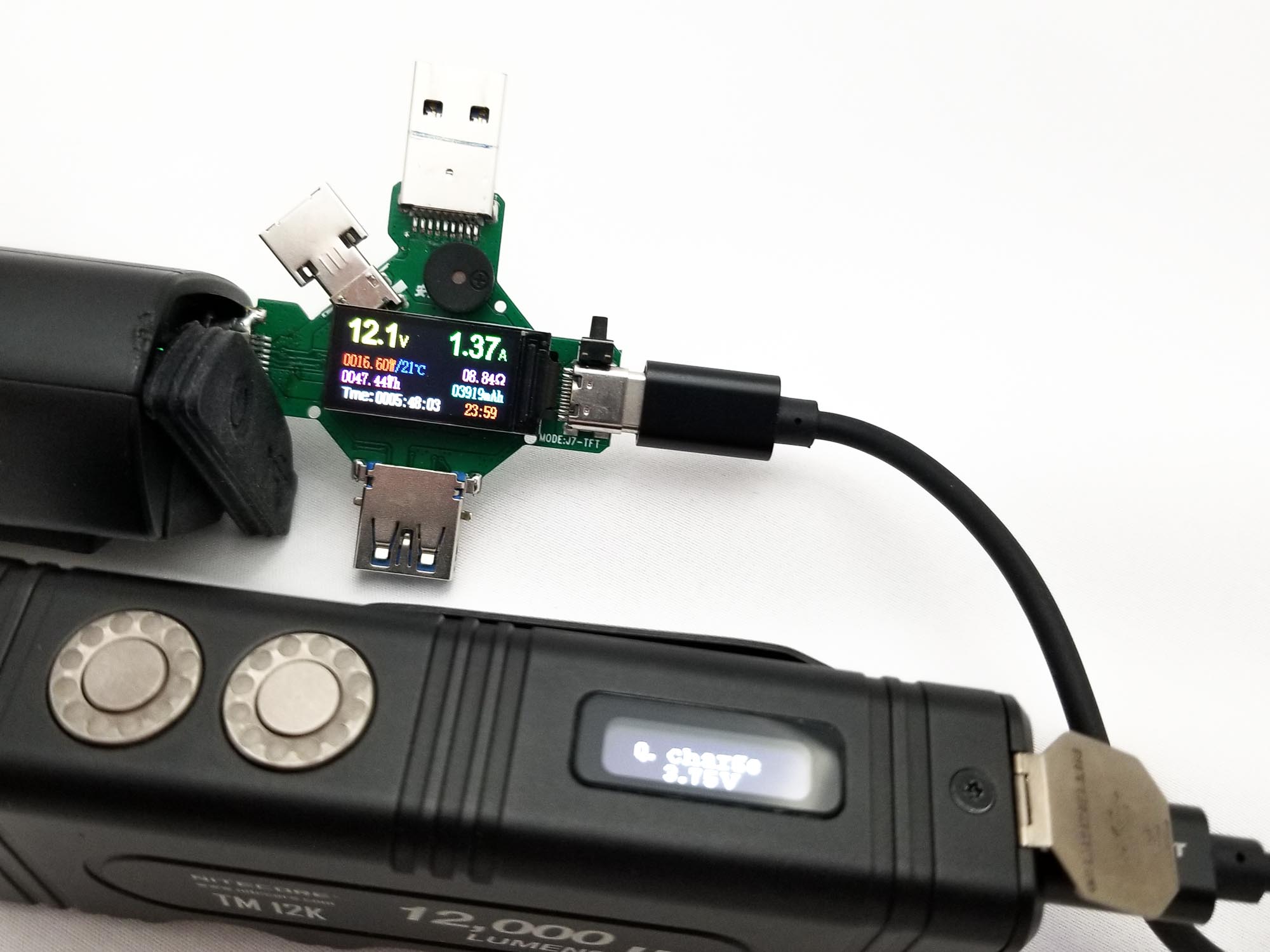
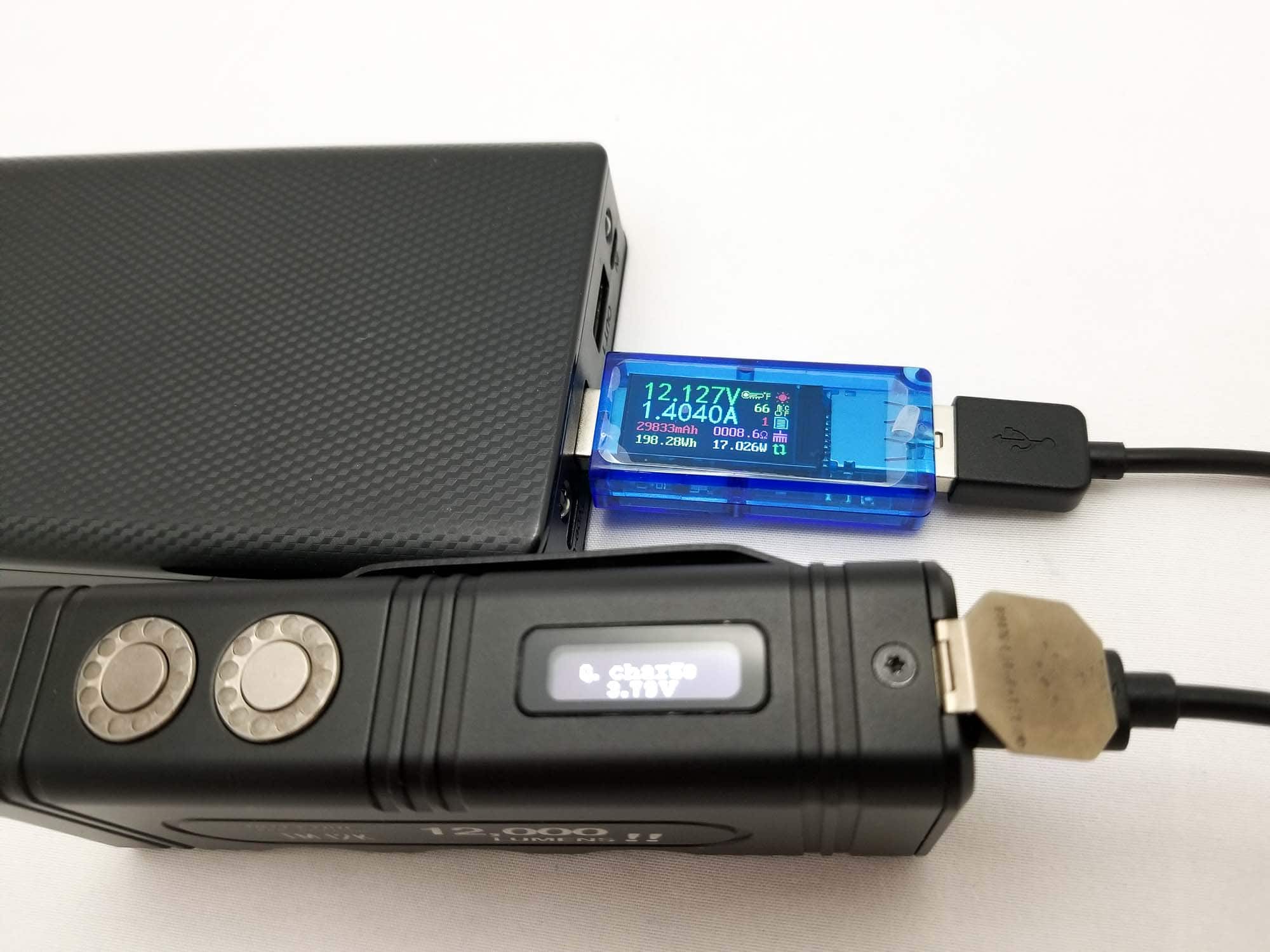

Performance test
Lumen measurements
Lumens are measured in my 50 cm integrating sphere with a Digi-Sense 20250-00 data logging luxmeter. The sphere has been calibrated with a Convoy S2+ measured to 260 Lumens and the figures are within 10% of actual. The internal battery was fully charged for the readings. No amp readings due to the integrated battery. I tested Mid, the High default setting, as well as the 2000 Lumen maximum High setting.
| Mode | Specified | turn on | 30 sec | 10 minutes |
|---|---|---|---|---|
| Ultra Low | 6 | 4.4 lm | 4.4 lm | – |
| Low | 100 | 107 lm | 107 lm | – |
| Mid | 300 | 341 lm | 341 lm | 339 lm |
| High (default) | 1000 | 1,023 lm | 1,023 lm | 1001 lm |
| High (max) | 2000 | 2,057 lm | 2,035 lm | 297 lm |
| Turbo | 12,000 | 12,650 lm | 1,980 lm | *N/A |
Parasitic drain:
- N/A
There’s no 10 minute data for Turbo because it didn’t last 10 minutes. The nature of the Turbo functionality means there’s a cool-down period after extended forays into Turbo mode. In addition, after just 3 minutes of Turbo activations back to back, the battery had started to sag and the output decreased.
Battery Life: Runtime graphs
Runtimes are measured in my 50 cm integrating sphere with a Digi-Sense 20250-00 data logging luxmeter. The sphere has been calibrated with a Convoy S2+ measured to 260 Lumens and the figures are within 10% of actual. The internal battery was fully charged for the tests. I measured Mid the default High mode (1000 Lumens) and the maximum High mode (2000 Lumens).
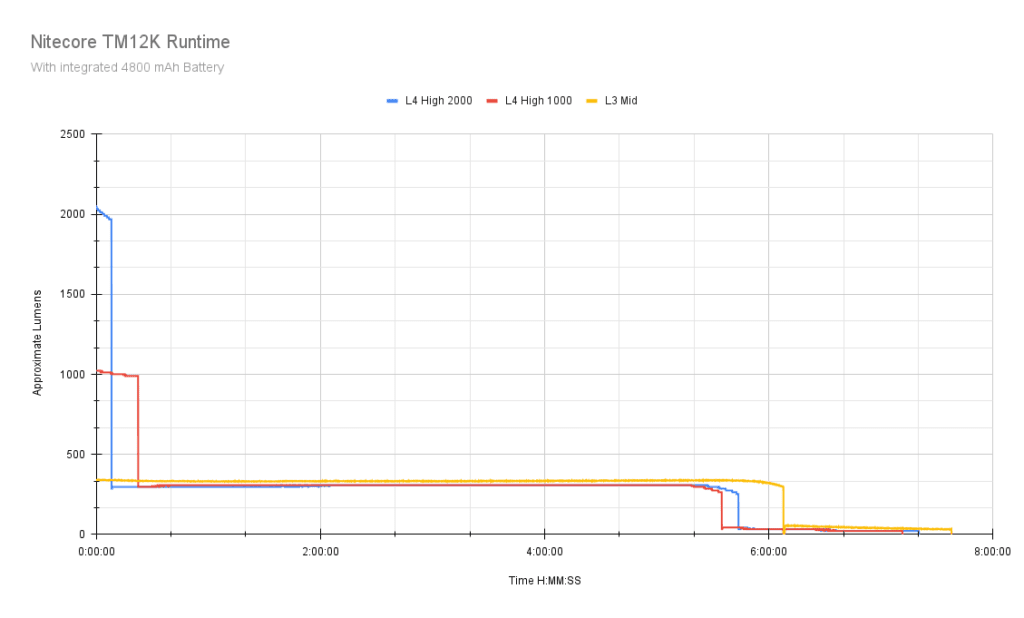
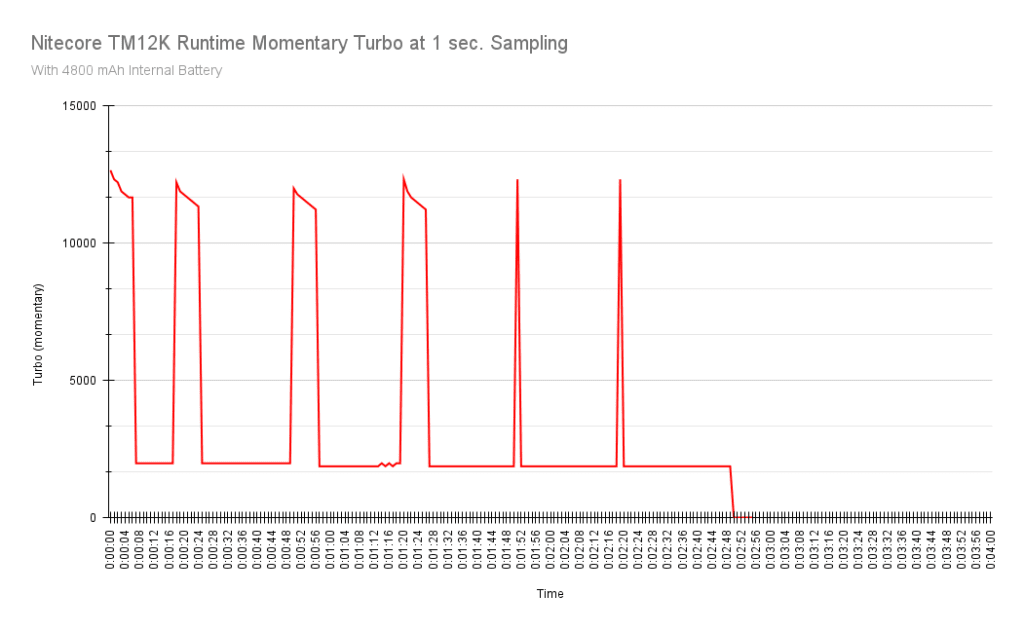
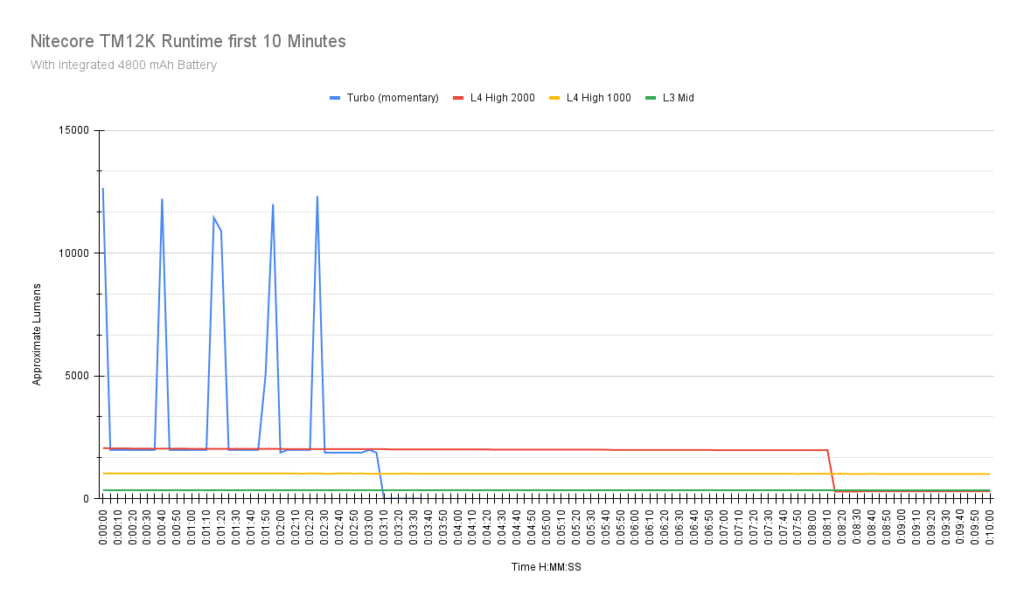
| Mode | Specified | Measured runtime (ANSI) | Time till shut off |
|---|---|---|---|
| Mid | 7h 30min | 7h 37min | 7h 37min |
| High (default 1000 Lumens) | 2h 15min | 5h 34 min | 7h 11min |
| High (max 2000 Lumens) | ? | 5h 43min | 7h 20min |
Turbo mode wasn’t measured because it doesn’t have a runtime. It’s essentially a timed burst mode and measuring a full runtime is impossible, so I did a short run with it to show the timed step down, and a few reactivations to show the thermal ramp down and shut off. We can see the duration of the Turbo runs decrease as the light gets heat soaked. After the last Turbo activation, the light would not go into Turbo again and would only go as high as High mode. It took about 3 minutes for it to cool off enough to re activate Turbo. I have no idea where Nitecore gets 2 hours 15 minutes for the High runtime, since at 2 hours 15 minutes the output is 308 Lumens and doesn’t change much for the next 4 hours. The maximum High mode 2000 Lumens is more of the same, and both the 1000 and 2000 Lumen settings had the same output after the step down to about 290 Lumens at 8 minutes 15 seconds for the maximum setting and 22 minutes 30 seconds for the default setting. Heat wasn’t a big deal here due to the low outputs after the drops: Both High settings never went over 50 C, and the TM12K was hand friendly the entirety of the tests.
ANSI FL1 standards: The runtime is measured until the light drops to 10% of its initial output (30 seconds after turning on). This does not mean that the flashlight is not usable anymore. The last column shows how long the light actually works till it shuts off. If there is a + symbol, it means that the test was stopped at that particular point, but the light was actually still running. This happens on certain occasions, with certain drivers, firmware, or batteries.
Peak beam intensity and beam distance measurements
Beam distanc0es are measured using a Uni-T UT383S luxmeter measured indoors at 5 meters with the fully charged included battery. Measurements taken at 30 seconds.
| Mode | Specs | Candela measured | Meters | Yards |
|---|---|---|---|---|
| Ultra Low | 7 cd | N/A | N/A | N/A |
| Low | 118 cd | 150 | 24.5 | 26.8 |
| Mid | 330 cd | 375 | 38.7 | 42.3 |
| High default (1000 Lumens) | 1,280 cd | 1525 | 78.1 | 85.4 |
| High max (2000 Lumens) | ? | 2475 | 99.5 | 108.8 |
| Turbo (at 5 seconds) | 15,600 cd | 14,275 (15,200 @ 0 sec) | 239.6 (246.5) | 262 (269.6) |
I tested the maximum setting for High mode to see how it compared to the default High setting. Since Turbo doesn’t last for 30 seconds, I measured the output right before the step down at 5 seconds and turn-on.
Extra info: Peak beam distance according to ANSI FL1 standards: The calculated value of distance in meters at which the flashlight produces a light intensity of 0.25 lux. (0.25 lux is about the brightness of a full moon shining on an object). Columns Meters and Yards show rounded numbers.
Beamshots
I compared the TM12K to some other high output multi-emitter floody flashlights. Photos taken with my Samsung Note 8. The 95 meter shots with the camera set to 0.3s ISO 200 and 5000K WB.
Beamshots of the following flashlights compared:
- Astrolux FT02s
- Imalent R30C
- Astrolux MF01 Mini
- Thrunite TN50
- Wurkkos TS32 (flood mode)
- Nightwatch NS59v1








Disclaimer: This flashlight was sent to me for review at no cost by Nitecore. I have not been paid to review, nor have I been holding back on problems or defects.
Final Verdict
Pros
- Compact form factor
- High quality and well-made
- High output and meets specs
- Intuitive, effective UI works good with 3 switches
- Functional and useful OLED display
- Quick charging
- Lanyard hole can accept ⅛” paracord
Cons
- Turbo is momentary with a very short runtime
- Rear switch
- Expensive!
Explanation on star ratings:
1: Avoid: a match would be a better choice – 2: Poor: significant defect or issues; almost unusable – 3: Average: some defects or issues; but still usable 4: Good: recommended (minor issues) – 5: Great: highly recommended

4 stars: ★★★★
In fairly adjudicating the Nitecore TM12K, I kind of had to define what it isn’t, other than what it is. What the TM12K isn’t is a tactical light…the very short Turbo mode, triple buttons, nearly non-existent rear switch travel, and somewhat awkward grip requirements, sort of disqualify it from serious tactical or duty use. Although you could EDC this light, it’s a bit heavy and bulky for prolonged pocket carry.
With that out of the way, what the TM12K excels at is throwing tons of light over a big area. It does it just as good as something like the Nightwatch NS59v1, or the Thrunite TN50, and even as good as the Fenix LR80R. It even hangs with the Wurkkos TS32 in its flood mode. The throw isn’t bad either for all that coverage. Also nice was the OLED display, which if anything else was a cool visual aid, sort of like a gauge set on a vehicle or machine. Seeing what the light was doing was cool.
Other features I liked were the extra-large lanyard hole, the intuitive UI, and it’s pretty small for 12,000 (verified) Lumens. Typical Nitecore stuff was also accounted for, like accurate factory specs, exceptional build quality, and attention to detail. I know all that usually comes at a fiduciary penalty, but $260 for this? I really enjoyed using the TM12K, and the compact size and form factor contributed to its portability and usefulness.
I’m not bashing it for the ugly Cree tint since this isn’t an enthusiast light meant to cater to the tint-conscious crowd. Assigning a rating was pretty tough. However, I’m giving it 4 stars. The combination of high quality, intuitive operation, accurate specs, and unique form factor really makes the TM12K a stand-out amongst its peers, and there really aren’t any other lights like this one. If you can afford it, give it a look if you want to try something…different.
Nitecore TM12K discount code
Get 15% off by using discount code 15OFF on orders above $75. Below $75, use our unique coupon code 1Lumen to get 10% off.
1lumen selects and reviews products personally. We may earn affiliate commissions through our links, which help support our testing.